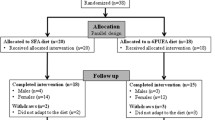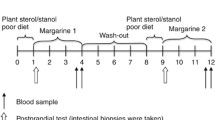Abstract
We studied the interrelationship of diet and plant sterols (PS) on plasma lipids, lipoproteins and carotenoids. Mildly hypercholesterolemic men (n = 13) and postmenopausal women (n = 9) underwent four randomized, crossover, double-blind, controlled feeding periods of 23 days each. The design consisted of two levels of PS (0 and 3.3 g/day) and two background diets having fat content either typical of the American diet (total and saturated fat at 33.5 and 13.2% of energy, respectively), or a Step 1 type of diet (total and saturated fat at 26.4 and 7.7% of energy, respectively). Plasma total cholesterol (TC), high density lipoprotein (HDL) cholesterol, low density lipoprotein (LDL) cholesterol, Apo A1 and Apo B were 4.3, 5.3, 4.5, 2.8 and 2.5% lower, respectively (P ≤ 0.0001; <0.0001, 0.0016, 0.0006, and 0.0069), with the Step 1 diet than with the typical American diet. Diet had no effect on TC/HDL cholesterol (P = 0.1062). Plant sterol intake lowered TC, LDL cholesterol, and Apo B by 9.0, 12.4 and 6.1% and TC/HDLC by 9.6% (P ≤ 0.0001 for all), respectively, without affecting HDL cholesterol and Apo A1 (P = 0.2831 and 0.732). The PS effect in lowering plasma TC and LDL cholesterol was independent of and additive to the effect due to dietary fat reduction. Responses of plasma carotenoids to PS intake were consistent with the literature.
Similar content being viewed by others
Abbreviations
- Apo A1:
-
Apolipoprotein A1
- Apo B:
-
Apolipoprotein B
- BHNRC:
-
Beltsville Human Nutrition Research Center
- HDL:
-
High density lipoprotein
- HPLC:
-
High-performance liquid chromatography
- HRT:
-
Hormone-replacement therapy
- LDL:
-
Low density lipoprotein
- NCEP:
-
National Cholesterol Education Program
- PS:
-
Plant sterols
- SEM:
-
Standard error of the mean
- SFA:
-
Saturated fatty acid
- TAD:
-
Typical American Diet
- TC:
-
Total cholesterol
- TAG:
-
Triacylglycerides
- USDA:
-
US Department of Agriculture
References
Miettinen TA, Puska P, Gylling H, Vanhanen H, Vartiainen E (1995) Reduction of serum cholesterol with sitostanol-ester margarine in a mildly hypercholesterolemic population. N Engl J Med 333:1308–1312
Katan MB, Grundy SM, Jones P, Law M, Miettinen T, Paoletti R (2003) Efficacy and safety of plant stanols and sterols in the management of blood cholesterol levels. Mayo Clin Proc 78:965–978
Ostlund RE Jr (2002) Phytosterols in human nutrition. Annu Rev Nutr 22:533–549
Lichtenstein AH (2002) Plant sterols and blood lipid levels. Curr Opin Clin Nutr Metab Care 5:147–152
Plat J, Mensink RP (2005) Plant stanol and sterol esters in the control of blood cholesterol levels: mechanism and safety aspects. Am J Cardiol 96:15D–22D
Nestel P, Cehun M, Pomeroy S, Abbey M, Weldon G (2001) Cholesterol-lowering effects of plant sterol esters and non-esterified stanols in margarine, butter and low-fat foods. Eur J Clin Nutr 55:1084–1090
Miettinen TA, Vanhanen H (1994) Dietary sitostanol related to absorption, synthesis and serum level of cholesterol in different apolipoprotein E phenotypes. Atherosclerosis 105:217–226
Pelletier X, Belbraouet S, Mirabel D, Mordret F, Perrin JL, Pages X, Debry G (1995) A diet moderately enriched in phytosterols lowers plasma cholesterol concentrations in normocholesterolemic humans. Ann Nutr Metab 39:291–295
Hallikainen MA, Sarkkinen ES, Gylling H, Erkkila AT, Uusitupa MI (2000) Comparison of the effects of plant sterol ester and plant stanol ester-enriched margarines in lowering serum cholesterol concentrations in hypercholesterolaemic subjects on a low-fat diet. Eur J Clin Nutr 54:715–725
Weststrate JA, Meijer GW (1998) Plant sterol-enriched margarines and reduction of plasma total- and LDL-cholesterol concentrations in normocholesterolaemic and mildly hypercholesterolaemic subjects. Eur J Clin Nutr 52:334–343
Maki KC, Davidson MH, Umporowicz DM, Schaefer EJ, Dicklin MR, Ingram KA, Chen S, McNamara JR, Gebhart BW, Ribaya-Mercado JD, Perrone G, Robins SJ, Franke WC (2001) Lipid responses to plant-sterol-enriched reduced-fat spreads incorporated into a National Cholesterol Education Program Step I diet. Am J Clin Nutr 74:33–43
Jones PJ, Ntanios FY, Raeini-Sarjaz M, Vanstone CA (1999) Cholesterol-lowering efficacy of a sitostanol-containing phytosterol mixture with a prudent diet in hyperlipidemic men. Am J Clin Nutr 69:1144–1150
Judd JT, Baer DJ, Chen SC, Clevidence BA, Muesing RA, Kramer M, Meijer GW (2002) Plant sterol esters lower plasma lipids and most carotenoids in mildly hypercholesterolemic adults. Lipids 37:33–42
Vanstone CA, Raeini-Sarjaz M, Parsons WE, Jones PJ (2002) Unesterified plant sterols and stanols lower LDL-cholesterol concentrations equivalently in hypercholesterolemic persons. Am J Clin Nutr 76:1272–1278
Gylling H, Miettinen TA (1999) Cholesterol reduction by different plant stanol mixtures and with variable fat intake. Metabolism 48:575–580
Third Report of the National Cholesterol Education Program (NCEP) Expert Panel on Detection, Evaluation, and Treatment of High Blood Cholesterol in Adults (Adult Treatment Panel III) final report (2002) Circulation 106:3143–3421
Kris-Etherton PM, Dietschy J (1997) Design criteria for studies examining individual fatty acid effects on cardiovascular disease risk factors: human and animal studies. Am J Clin Nutr 65:1590S–1596S
Composition of foods, agriculture handbook no. 8, sections 1–22. In: US Department of Agriculture HNIS (ed), US Government Printing Office, 1976–1990
Holden JM, Eldridge AL, Beecher GR, Buzzard IM, Bhagwat SA, Davis CS, Douglass LW, Gebhardt SE, Haytowitz DB, Schakel S (1999) Carotenoid content of US foods: an update of the database. J Food Comp Anal 12:169–196
Hainline A, Karon J, Lippel K (1982) Manual of laboratory operations: lipid and lipoprotein analysis. In: USGPO HEW (ed) Lipid research clinics program pub no. (NIH) 75–628 (rev.). National Heart Lung and Blood Institute, Bethesda
Friedewald WT, Levy RI, Fredrickson DS (1972) Estimation of the concentration of low-density lipoprotein cholesterol in plasma, without use of the preparative ultracentrifuge. Clin Chem 18:499–502
Khachik F, Beecher GR, Goli MB, Lusby WR, Smith JC Jr (1992) Separation and identification of carotenoids and their oxidation products in the extracts of human plasma. Anal Chem 64:2111–2122
Bieri JG, Brown ED, Smith JC Jr (1985) Determination of individual carotenoids in human plasma by high performance liquid chromatography. J Liq Chromatogr 8:473–484
Littell RC, Milliken GA, Stroup WW, Wolfinger RD (1996) SAS system for mixed models. SAS, Cary
SAS/STAT (2003) User’s guide. Version 9.1.3. Cary, NC: SAS Institute Inc.
Allison DB, Egan SK, Barraj LM, Caughman C, Infante M, Heimbach JT (1999) Estimated intakes of trans fatty and other fatty acids in the US population. J Am Diet Assoc 99:166–174 (quiz 175–176)
What we eat in America, NHANES 2005–2006: documentation and data files (2008). In: US Department of Agriculture ARS (ed)
Walldius G, Jungner I, Aastveit AH, Holme I, Furberg CD, Sniderman AD (2004) The apoB/apoA–I ratio is better than the cholesterol ratios to estimate the balance between plasma proatherogenic and antiatherogenic lipoproteins and to predict coronary risk. Clin Chem Lab Med 42:1355–1363
Ginsberg HN, Kris-Etherton P, Dennis B, Elmer PJ, Ershow A, Lefevre M, Pearson T, Roheim P, Ramakrishnan R, Reed R, Stewart K, Stewart P, Phillips K, Anderson N (1998) Effects of reducing dietary saturated fatty acids on plasma lipids and lipoproteins in healthy subjects: the DELTA study, protocol 1. Arterioscler Thromb Vasc Biol 18:441–449
Richelle M, Enslen M, Hager C, Groux M, Tavazzi I, Godin JP, Berger A, Metairon S, Quaile S, Piguet-Welsch C, Sagalowicz L, Green H, Fay LB (2004) Both free and esterified plant sterols reduce cholesterol absorption and the bioavailability of beta-carotene and alpha-tocopherol in normocholesterolemic humans. Am J Clin Nutr 80:171–177
Parker RS, Swanson JE, You CS, Edwards AJ, Huang T (1999) Bioavailability of carotenoids in human subjects. Proc Nutr Soc 58:155–162
Acknowledgments
This paper is dedicated to our late mentor, colleague, and friend, David Kritchevsky, Ph.D. We are grateful to Elke Trautwein, Ph.D., of the Unilever Food and Health Research Institute for helpful discussions; Richard A. Muesing, Ph.D., of George Washington University for determining plasma concentrations of lipids, apoproteins, and lipoprotein cholesterols. Supported in part through a Research Support Agreement between the Agricultural Research Service, US Department of Agriculture, and Unilever US, Englewood Cliffs, NJ.
Conflict of interest statement
J.T. Judd, M. Kramer, B.A. Clevidence, and D.J. Baer, no conflicts of interest. S.C. Chen was an employee of Unilever Foods, NA at the time the dietary portion of the study was conducted. G.W. Meijer is an employee of Unilever.
Author information
Authors and Affiliations
Corresponding author
Additional information
Mention of trade names or commercial products in this article is solely for the purpose of providing specific information and does not imply recommendation or endorsement by the US Department of Agriculture.
About this article
Cite this article
Chen, S.C., Judd, J.T., Kramer, M. et al. Phytosterol Intake and Dietary Fat Reduction are Independent and Additive in their Ability to Reduce Plasma LDL Cholesterol. Lipids 44, 273–281 (2009). https://doi.org/10.1007/s11745-008-3278-y
Received:
Accepted:
Published:
Issue Date:
DOI: https://doi.org/10.1007/s11745-008-3278-y




